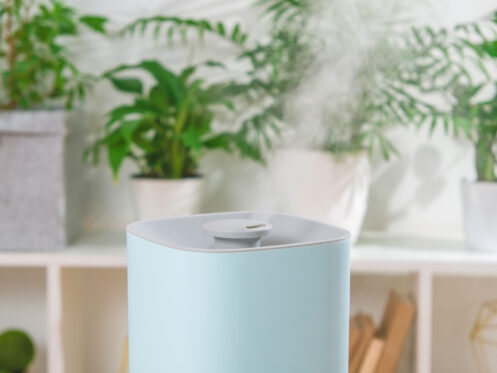According to the Environmental Protection Agency (EPA), the quality of air inside your Riverside, CA home is likely two to five times more polluted than the air outdoors. This is unnerving when you consider the exhaust from all nearby cars, airborne contaminants from local factories, airports, and plants, and the exhaust gases emitted by gas-fired appliances in the region. The good news is that you may be able to freshen things up by simply filling your living space with houseplants. Plants extract carbon dioxide from the air to support photosynthesis and release oxygen. This ongoing transfer freshens indoor air and makes homes more habitable and healthy for humans and pets.
Why Running Your HVAC System Might Not Be Enough
Like many consumers, you might rely heavily on your HVAC system to protect your indoor air quality (IAQ). High-performing HVAC systems don’t just regulate the temperatures inside of homes. They also extract excess moisture from the air and filter out a variety of common contaminants, including:
- Textile and carpet fibers
- Pet and human hair
- Dust mites
- Pollen
You know that your air filter is doing a good job of cleaning your indoor air when you extract it and find a thick, lint-like mat of debris. However, these accumulations represent just a small fraction of what’s actually floating throughout your home.
All HVAC air filters sold and installed throughout North America come with a maximum efficiency reporting value (MERV) rating. MERV ratings run from one to 20, and the higher a filter’s MERV rating is, the more contaminants it can extract. Unfortunately, the filter that came with your HVAC system likely has a low MERV rating. These units are largely designed to keep particulates out of air conditioners, heaters, and HVAC ductwork rather than out of residents’ airways. Although they’re effective for protecting HVAC equipment, they’re far less effective for protecting you and your family.
There are also many indoor contaminants that slip right through filter mesh. Even with a clean air filter in place, your indoor air could be rife with mold spores, bacteria, viruses, volatile organic compounds (VOCs), and more. Whether brought into homes by residents, off-gassed by building materials, or released while cleaning or cooking, these things can create symptoms like coughing, sneezing, nasal irritation, headaches, and low energy.
Upgrading your air filter to one that picks up a greater range of indoor contaminants is one way to improve your IAQ. However, it’s also important to have secondary measures for removing the allergens and contaminants that it can’t collect. According to the National Aeronautics and Space Administration (NASA), adding houseplants to your home may be an effective supporting measure.
Benefits of Having Houseplants
Plants “breathe” in what humans breathe out and add more oxygen to the air in the process. However, this isn’t all that they do to improve IAQ. In a 1989 study entitled “Interior Landscape Plants for Indoor Air Pollution Abatement,” NASA cited houseplants as effective and economical solutions to a number of known toxins such as benzene, formaldehyde, and trichloroethylene. Plants like English ivy, peace lilies, Gerbera daisies, and chrysanthemums were tested for their ability to extract chemical contaminants when placed in sealed, low-ventilation environments. The results were remarkable. Over just a 24-hour period, notable decreases in various contaminants occurred, with houseplants having larger, total leaf area doing the most work.
Houseplants provide a wonderful array of mood-boosting benefits as well. Having houseplants throughout your home is associated with lower levels of stress and anxiety, increased focus, and fresher-smelling indoor air. The right houseplants can also add moisture to buildings, thereby naturally combating problems with overly dry conditions.
Which Houseplants Provide the Best IAQ Benefits?
Janet Craig (Dracaena deremensis), green spider plants, and bamboo palm were among the highest performers in NASA’s 1989 study. Some of these plants removed as much as 75,000 micrograms of airborne contaminants over a 24-hour period. Other high-performing plants for improving IAQ include sword fern, snake plant, philodendron, and aglaonema.
Why Creating an Indoor Jungle Might Not Work Like You Want It To
With houseplants as your primary arsenal against indoor toxins, it’s important to note that the purported benefits of houseplants for IAQ largely hinge on NASA’s single, 1989 study. Moreover, this study was performed in a tightly controlled environment, and all plants involved were subject to special conditions. Among these conditions were activated carbon soil systems, squirrel cage fans powered by electric motors, fan timers, and drainage streamlined to inhibit the development of mold, fungi, and other common soil problems. In short, there’s no easy way to replicate the results that NASA achieved, and there’s really no way of knowing for certain how well houseplants in standard potting soil will deliver.
While the general consensus is that houseplants can indeed contribute to a more pleasant and all-around healthier living space, they’re as of yet unproven in their ability to extract key indoor contaminants make them too high-risk for use as a standalone IAQ solution. This is especially true if you have newborn infants, people with compromised immune systems, aging adults, or residents with chronic respiratory ailments in your home. These people are counting on you for effective IAQ measures, and most houseplants are all but guaranteed to fall short in highly contaminated environments.
Alternative Ways to Improve Your IAQ
Having a few living plants spread throughout your home will help freshen things up even if it won’t meet all of your IAQ needs. However, you should also stay up to date with HVAC system maintenance by regularly changing your HVAC air filters, having your air ducts cleaned every three to five years, and scheduling service for your heater and air conditioner annually. You can also take steps to better ventilate your home by adding additional mechanical ventilation and by keeping your current mechanical ventilation (range hood fans and bathroom exhaust fans) clean.
Don’t Count on Houseplants to Keep You Healthy
There’s another important drawback of using houseplants as your primary IAQ boosters. This is their inability to remove germs. Harmful pathogens like viruses, bacteria, and fungi are all but impervious to houseplants. Thus, if mold, mildew, or recurring illnesses are among your top IAQ concerns, loading up your home with houseplants won’t help. Adding more plants to your home won’t reduce the transmission of communicable illness or keep dangerous germs from settling on high-touch surfaces. Worse still, too many plants in any closed environment can also create more habitable conditions for many of these organisms. With an abundance of plants adding moisture to your indoor air, mold and mildew could proliferate.
Integrated HVAC Accessories and Their Role in IAQ Improvement
The absolute best way to give your IAQ a boost is by installing integrated HVAC accessories. Options like media filters, air scrubbers, whole-house air purifiers, and UV sanitizing lights will do a far better job of extracting the allergens, contaminants, and pathogens that slip right through your HVAC air filter. Whether installed inside of your ductwork or connected directly to it, many of these additions can do what even the highest-performing plants cannot: eliminate viruses, fungi, and bacteria. With the right IAQ equipment installed, you’ll have fewer germs settling on indoor surfaces, fewer VOCs suspended in the air, and fewer allergens and other particulates floating from room to room.
We help residents of Riverside, CA maintain clean, comfortable, and healthy homes. We offer heating, cooling, plumbing, and indoor air quality services. You can also count on us for the latest options in integrated HVAC accessories, whole-house fans, and solar attic fans. To schedule an appointment, get in touch with Sheldon's Heating & Air Conditioning now.




